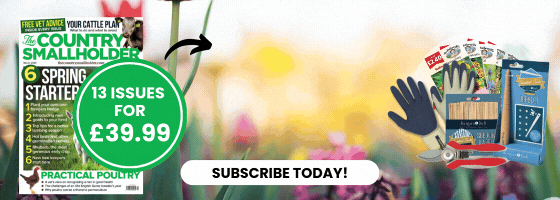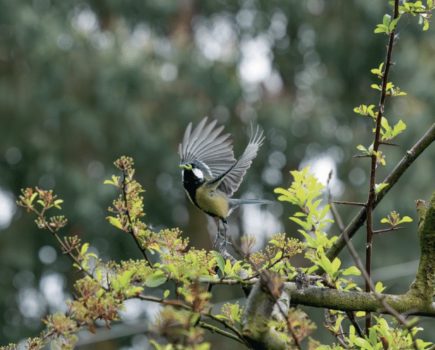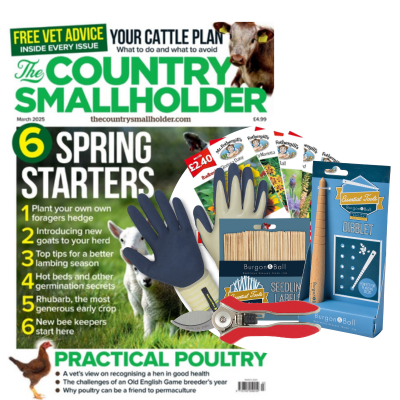Jack Cockburn has established a herd of Traditional Herefords, and extols the virtues of the breed
I began farming our small organic farm in west Wales in 2005. At the age of 26, I had a postgraduate certificate in organic agriculture, but very little practical farming experience. I had never worked with cattle before, so the thought of keeping such large animals was quite daunting. I had no idea how I would handle them, or move them around, and was a little frightened of cattle at close quarters! I had long planned to keep cattle as well as sheep and was determined to see cows grazing our land, complementing the sheep enterprise. The plan was to produce grass-finished organic beef and lamb to sell to guests staying in the holiday cottages on the farm and send out boxes of meat to customers by courier. In 2005, I entered the farm into organic conversion with the Soil Association and into a Welsh agrienvironment scheme called Tir Gofal. My plans for the 50 acres of grassland at Treberfedd Farm placed a small herd of beef cattle as an integral part of the organic farm system. The grazing cattle would help provide clean, parasite-free grazing for the newly established flock of Llanwenog sheep, provide manure to put back onto the hay meadows and they would be good at utilising the rougher wildlife rich conservation pastures at Treberfedd. So where to get these beasts, and what breedshould I go for? I researched the various native beef breeds to see which would be most suitable for my situation. The Soil Association encourage the use of native breeds in organic farming so that they are naturally adapted to the local climate and land type. With this in mind, I decided I was looking for a native breed of cow which would be easy to handle and docile, produce high-quality beef and thrive off grass and forage without needing bought in concentrate feed. I narrowed it down to a choice between Welsh Black Cattle or Herefords. After reading up on the two breeds, I soon began to favour the Hereford. Every description of the Hereford I read mentioned how docile and easygoing the breed is whilst being excellent converters of grass and forage into high quality beef. In June 2005, I saw a local advertisement: ‘Two pedigree traditional Hereford heifers for sale, quiet and easy to handle, halter trained’. I had planned to wait until I had got to grips with the sheep flock first, and then buy some cows the following year, but I couldn’t resist going to have a look. A week later ‘Connie’ and ‘Bonny’ arrived on the farm. They were half sisters aged two and three, both registered Traditional Herefords raised on a smallholding near Lampeter, West Wales. They were very laid back in character, so much so that if they were lying down in the field you could use them as acomfy seat and they wouldn’t bat an eyelid. So, I had got my first cattle, but had also entered into the conservation of a rare breed. The heifers’ status as ‘Traditional Herefords’ meant they were part of a small nucleus stock of Herefords whose pedigree could be traced right back to the first Hereford herd book of 1847. The breeders of Connie and Bonnie put me in touch with the Rare Breed Survival Trust who were able to provide bull semen so we could use artificial insemination to get the heifers in calf. The following spring (2006), both cows gave birth to heifer calves, both sired by a bull called ‘Hartre Donald’ who had been born himself in 1968! We registered our herd name ‘Aeron Herefords’ with the Hereford Breed Society and then registered the calves as ‘Aeron Bluebell’ and ‘Aeron Rose’. Six years later, and the two original cows are both grandmothers. They have produced 11 calves between them, four of which have joined the herd of breeding cows and had calves themselves. Breeding numbers have slowly been built up, and the Aeron herd of traditional Hereford cattle now has 22 breeding cows plus 20 followers. I believe Traditional Herefords are ideal cattle for smallholders who want to start a small beef herd, and they are a lot less trouble than sheep! They are docile and easy to handle and can thrive on a low input sustainable farm system. The beef is of excellent quality, ideal for direct sales and there is also a good market for quality breeding females. The Traditional Hereford should have a strong place in the future. The ability to produce meat efficiently from grass and marginal land makes the breed far more environmentally friendly than the larger, intensively farmed, grain-reared cattle favoured by the supermarkets. * To find out more about the Aeron Herd and their home at Treberfedd Farm visit the website at www.treberfedd.co.uk/the-farm or phone Jack Cockburn on 01570 470672FACTFILE • The Traditional Hereford is a compact, beefy, short-legged animal. • The coat is red in colour (preferably deep red) with white on the belly, brisket, legs, shoulder stripe and tail switch. • The Hereford is instantly recognisable by the white face, which has become its trademark for its quality. • Cows weigh 500 – 600kg on average. • Cows are long-lived and easy-calving producing a lively calf averaging 30 – 40kg• Bulls, when fully grown, are around 55 inches in height; cows are slightly smaller at around 50 to 53 inches • The ideal finished weight for the quality market is between 500 and 550kg, which can be met with steers of between 18 and 24 months. • Once killed, steers and heifers will yield a beef carcase of 250 – 350kg • Beef: one of the easiest breeds to fatten. Traditional Herefords will easily finish by 30 months of age on rough grazing and forage. The beef is of a high quality and prized by discerning butchers and customers. A hardy, versatile breed – thick skinned and has a coat which becomes very dense in the winter.
History of the Traditional HerefordThe Traditional Hereford was developed by Herefordshire and Welsh Border farmers some 250 years ago. The skilled breeders of the 18th and 19th century went on to develop an animal which was easy to maintain, had perfect symmetry, a kind temperament and was of a consistent type. The Hereford breed’s popularity quickly spread. Cattle farmers recognised the Hereford’s ability to efficiently turn grass into beef and milk. These cows would ‘keep the farmer’ not the other way round. During the 19th century, the Hereford became famed for its ability to efficiently convert grass and forage into high quality beef. Bulls and females were exported to North and South America, Australia and Africa and they were found to be extremely adaptable. Such was the popularity of the breedthat, by the 20th century, the Hereford was the world’s most numerous beefbreed.
As agriculture intensified and theabundance of grain increased, the North American Hereford breed was‘improved’ to create larger animals.
Today, most of the UK Hereford cattle are of the larger North American type.
These commercial animals meet the demands of the large beef processors and retailers but arguably require greater quantities of cereals to fatten.
In 1996, The Traditional Hereford Breeders Club and Rare Breeds Survival Trust recognised the importance of preserving the original type of Hereford.
For more information about the Traditional Hereford Breeders Club visit www.traditionalherefords.net or contact secretary David Fenton on 01580 762395.







